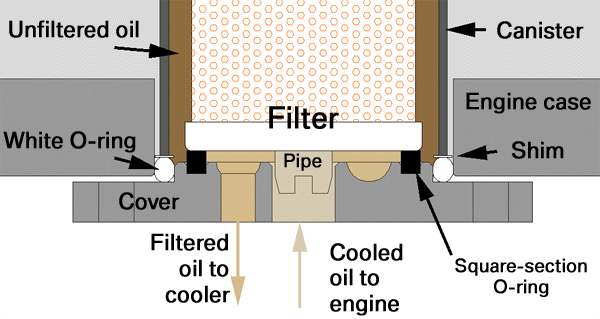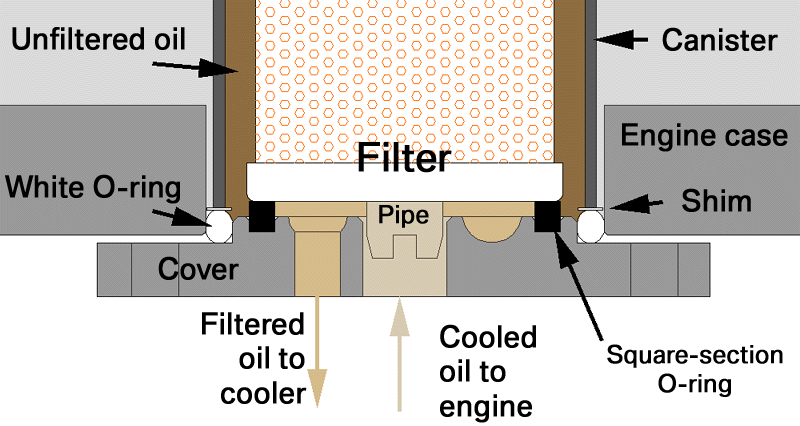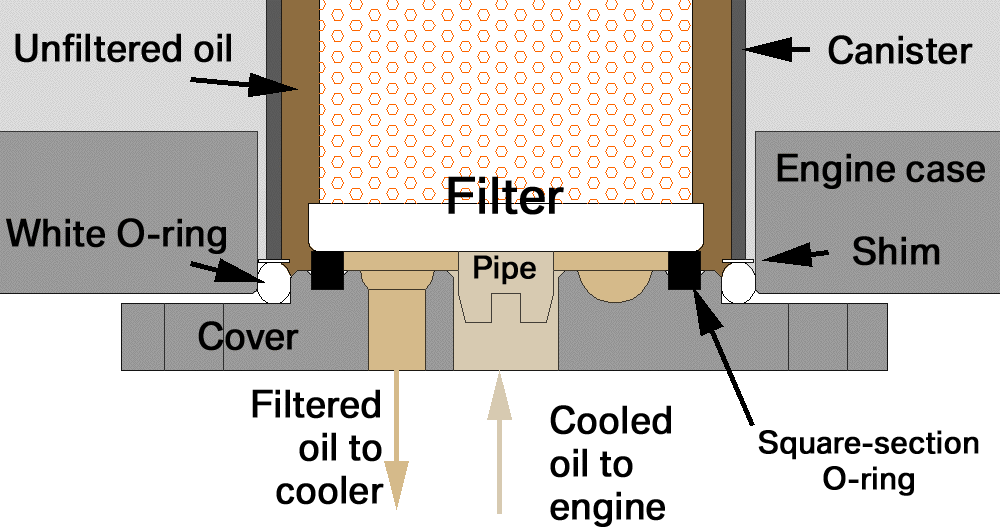The White O-ring
The infamous $2000 O-ring seals the pressurized oil inside the canister from the outside of the engine and also from the engine sump. The term was coined in the late '80s or early '90s after the potential monetary consequence of screwing up this part of an oil change (loss of oil pressure, ruined crankshaft and conrods, etc.). Currently the O-ring itself sells for less than $3, so it's a lot cheaper to get it right.
The following true-to-scale diagram shows the cover sealing arrangement of a model with a cooler, but the principle is the same without one. The cover is not tightened all the way down, so you can visualize further compression of the white O-ring when that happens. In the following diagram, pay close attention to specific points:
- Unfiltered oil is fed into the canister under pressure, outside the filter. This is blocked at the cover by the black square-section O-ring, forcing the oil to go through the filter. Additionally, it is blocked by the white O-ring which seals the gap between the canister lip and the cover. The white O-ring also seals the cover to the case. On cooler models, the oil is forced out the side hole in the cover and returns via the center hole which feeds the motor via the center tube.
- The white O-ring is 4mm thick, but the radial gap between the cover flange and the case is only 3.5mm, so as shown it is already compressed once it is in place. It is additionally compressed when the cover is tightened down.
- The shim prevents the canister edge from cutting into the O-ring. Some models have smooth canister edges which will not cut the O-ring, and the shim is not required for protection. It might still be required to provide enough O-ring compression.
- Yes you are seeing it right; if you use a shim, there is metal-to metal sealing of oil pressure from the inside of the canister back to the sump. This occurs between the shim and the canister edge, as shown. It is at this point (with or without a shim) where a cut or insufficiently compressed O-ring can leak oil pressure back into the sump. If you don't have a cover gasket in place, oil may leak out of the cover which is a great warning sign. Cover gaskets can mask this, which is why I try to do without them.
How do I figure out what to do?
For the short version, skip this entire section. It's only for those who want to know where the numbers come from.
When I say "Canister depth" I mean the depth of the canister edge below the case surface, and when I say "Groove depth" I mean the space into which the O-ring is compressed after the cover is tightened, taking into account the presence of a shim or two and/or a cover gasket. Here's some theory that you can skip if you want:
Basic dimensions
O-ring is 4.0x52mm OD, R=24mm, r=2mm
Shim is 0.3mm thick
Gasket is 0.45mm thick
Case hole is 52.0mm, R=26mm
Cover wall is 45.0mm, R=22.5mm
Derived dimensions:
O-ring groove floor area is pi((26mm)²-(22.5mm)²) = 533.3mm²
O-ring volume = 2pi²Rr² = 1895mm3
Groove filled (by volume) at 1895mm3/533.3mm2 = 3.55mm groove depth.
O-ring groove floor width (52mm-45mm)/2 = 3.5mm
O-ring cross-sectional area pi(2mm)² = 12.56mm2
Groove filled (by cross-section) at 12.56mm2/3.5mm = 3.6mm groove depth
These two calculations give the theoretical compression point at which the O-ring becomes square and packs out the space completely, determined two different ways. Obviously neither tells the whole story because O-rings are routinely compressed into spaces as small as 3.0mm. You can see chamfers on the cover and case where the O-ring can go, plus the shim flexes to allow the O-ring to extend farther into the engine case. However, HPN recommends 3.5 to 3.8 as a normal groove depth, so clearly they have positive experience with dimensions that don't fully compress the O-ring, whereas other BMW mechanics target smaller groove depths. Ultimately, credible sources target groove depths of 3.2 to 3.8mm, apparently without problem. You won't go wrong with anything in the middle of that. BMW specifies 3.1 to 3.8 in a 1983 service bulletin.
Shimming the cover
The reason we're discussing this at all is that canister depths vary enormously (in relative terms) from 2.6mm to 4.2mm or even more. One cover sealing configuration can't possibly deal with such a wide range, so unfortunately you must take ownership of this.
In simple terms, first you measure the canister depth and then you choose a stack of components which gives you the right amount of O-ring compression. Adding a metal shim increases the compression by 0.3mm, and using a cover gasket reduces it by 0.45mm. Remember, older bikes with a sharp-edged canister must have a shim to protect the O-ring. So, for instance, if you are looking for about a 3.3mm groove:
| Canister depth (mm) |
Shim optional (round edge) | Shim required (sharp edge) | ||||
|---|---|---|---|---|---|---|
| Gasket (adds 0.45mm) |
Shims (removes 0.3mm) |
Resulting Groove depth |
Gasket | Shims | Depth | |
| 2.9 | Yes | 0 | 3.35 | Yes | 1 | 3.05 |
| 3.0 | Yes | 0 | 3.45 | Yes | 1 | 3.15 |
| 3.1 | No | 0 | 3.1 | Yes | 1 | 3.25 |
| 3.2 | No | 0 | 3.2 | Yes | 1 | 3.35 |
| 3.3 | No | 0 | 3.3 | Yes | 1 | 3.45 |
| 3.4 | No | 0 | 3.4 | No | 1 | 3.1 |
| 3.5 | No | 1 | 3.2 | <- Same | ||
| 3.6 | No | 1 | 3.3 | |||
| 3.7 | No | 1 | 3.4 | |||
| 3.8 | No | 2 | 3.2 | |||
| 3.9 | No | 2 | 3.3 | |||
This is just an example, narrowly targeting a specific dimension! Do your own math to suit your own situation. In practice, the O-ring works in a fairly wide range of dimensions, so it's really unnecessary to apply this level of precision. You need to compress the O-ring, but it's not rocket science.
On an older engine with a sharp canister (where you need to use a shim) you might need to double up on the cover gasket if you have a very shallow canister depth. Fortunately, the very shallow canisters are rare. The lowest I've measured is 2.72mm on a 1978 motor.
Old vs. new canisters
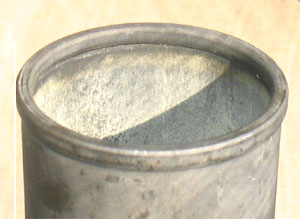
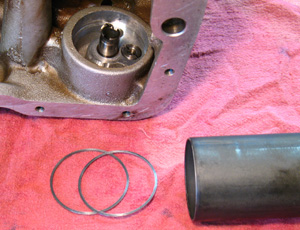 Old canisters were simple steel pipes, 50mm OD, 1.5mm wall thickness, about 139mm long. This presented a 1.5mm sharp-edged lip to seal against, requiring the metal shim to increase the surface area and protect the rubber O-ring from being cut. At the inner end, where it is pressed into the block, the OD is turned down to about 49.75mm.
Old canisters were simple steel pipes, 50mm OD, 1.5mm wall thickness, about 139mm long. This presented a 1.5mm sharp-edged lip to seal against, requiring the metal shim to increase the surface area and protect the rubber O-ring from being cut. At the inner end, where it is pressed into the block, the OD is turned down to about 49.75mm.
The new canister (shown at left) started in the late '80s, and is made from 1mm thick tubing but the end is flared and then rolled inward, providing a smooth 3.2mm surface on the business end. Since the shim was about the same width, the new canister provides the same surface area by itself, and a shim is truly only necessary for extra compression.
This new canister is 137.53~137.60mm deep. Installed in a case with a 142mm deep filter cavity, it must not be inserted fully. I have started using custom shims, as shown on the right, to control the canister insertion depth. This way the canister cannot get pushed deeper into the case in the future. I set them at 3.5mm.
Filters
